Last rancher on Point Reyes peninsula joins lawsuit against the Park Service
David Evans just joined the Niman lawsuit against the Park Service. He was never part of mediation talks and is not under a gag order. In a lengthy interview, he tells his side of the story.

David Evans, the last rancher on Point Reyes peninsula, is suing the National Park Service after the secretive deal that has his neighbors packing up to leave. Evans was not part of the lawsuit and subsequent mediation that resulted in their departure, and thus is not under a gag order. He is free to speak.
In a lengthy phone interview Thursday, Evans shared his perspective on the lawsuit, the actions of the Park Service, and the future of his ranch.
“I think there’s been efforts to try to squeeze ranching out of here for a long time,” says Evans. “Decades.”
Evans believes his being allowed to stay is no accident. He says his presence “props up the voluntary nature of the buyout.” The actions of the Park Service have led him to believe he will eventually be forced out, too.
“I want to go on the record and say, I was never offered a buyout,” he says. “I didn’t hold out. I was held out.”
“They have somebody to point to and say, ‘The other ranchers could have stayed just like David Evans.’”
That’s not how the situation has been framed by The Nature Conservancy, the multi-billion dollar conservation organization that will be taking over the leases of 12 ranching families on Point Reyes. In an email exchange with The Nature Conservancy, spokesperson Heather Gately reiterated that the lease buyout was voluntary.
“We're grateful that the parties came together to reach this hard-fought solution, and while some ranchers opted to receive compensation to move operations, other ranchers are opting to stay,” Gately said.
When asked to clarify which ranchers opted to stay, Gately responded that two ranching operations will remain within the Seashore—presumably the Niman and Evans families.
But Evans says this depiction is disingenuous, because he and the Nimans were never part of those talks and were never made an offer. The only two ranching families left on the Seashore are the two families who abstained from joining the lawsuit in the first place. Every ranching family who joined the lawsuit will be leaving. They are all under a gag order and unable to speak about what happened during the mediation process.
When Evans approached The Nature Conservancy after the record of decision (ROD) was announced, they told him they would not be offering him a buyout.
“I want options,” Evans says. Without the community he’s always known, ranching on the peninsula alone is a bleak future. Still, he says he understands why his neighbors made the choice they made. “I’m 100% in support of my neighbors taking a buyout and leaving if that’s what they want to do. At this point, they’ve been so pressured, I would go so far as to say abused. They were shown an impossible lease and an impossible circumstance with no future and then offered a buyout. To call something voluntary when there was no other option is a little disingenuous if you ask me. I really feel for what my neighbors have gone through.”
Evans believes his continued presence on the peninsula may be a ploy to make his neighbors’ absence appear optional.
“Why am I there? I don’t think its by coincidence. The only thing I can think is they want to have somebody to point to and say, ‘The other ranchers could have stayed just like David Evans.’ That’s not true by the way.”
The Niman family is further down the shore near the town of Bolinas. They recently sued the Park Service for rezoning the Seashore and foreclosing ranching as part of the future of the peninsula. Evans has joined their lawsuit.
“I decided to join Niman lawsuit because that’s what I need to do to find options for me and my family,” Evans says. With all his neighbors gone, Evans believes the Park Service plans to squeeze him out.
“I didn’t hold out. I was held out.”
In the initial 2016 lawsuit against the Park Service by a coalition of environmental groups, the Evans and Niman families chose to intervene along with their neighbors. Years of public comment, third party scrutiny, and exhaustive environmental review resulted in a clear recommendation: 20-year leases for the ranchers. Evans felt hopeful. Then the environmental groups, unhappy with that outcome, sued again.
“At that time my wife and I reassessed. Should we pay an attorney? Intervene? We just thought, unlike the rest of our neighbors we are going to just work with the Park Service and have faith they’ll be there for us.”
When it came to the lengthy, closed-door mediation between his neighbors and the three environmental groups—Resource Renewal Institute, Western Watersheds, and the Center for Biological Diversity—Evans was in the dark. When the final 2025 ROD was released, it came as a shock.
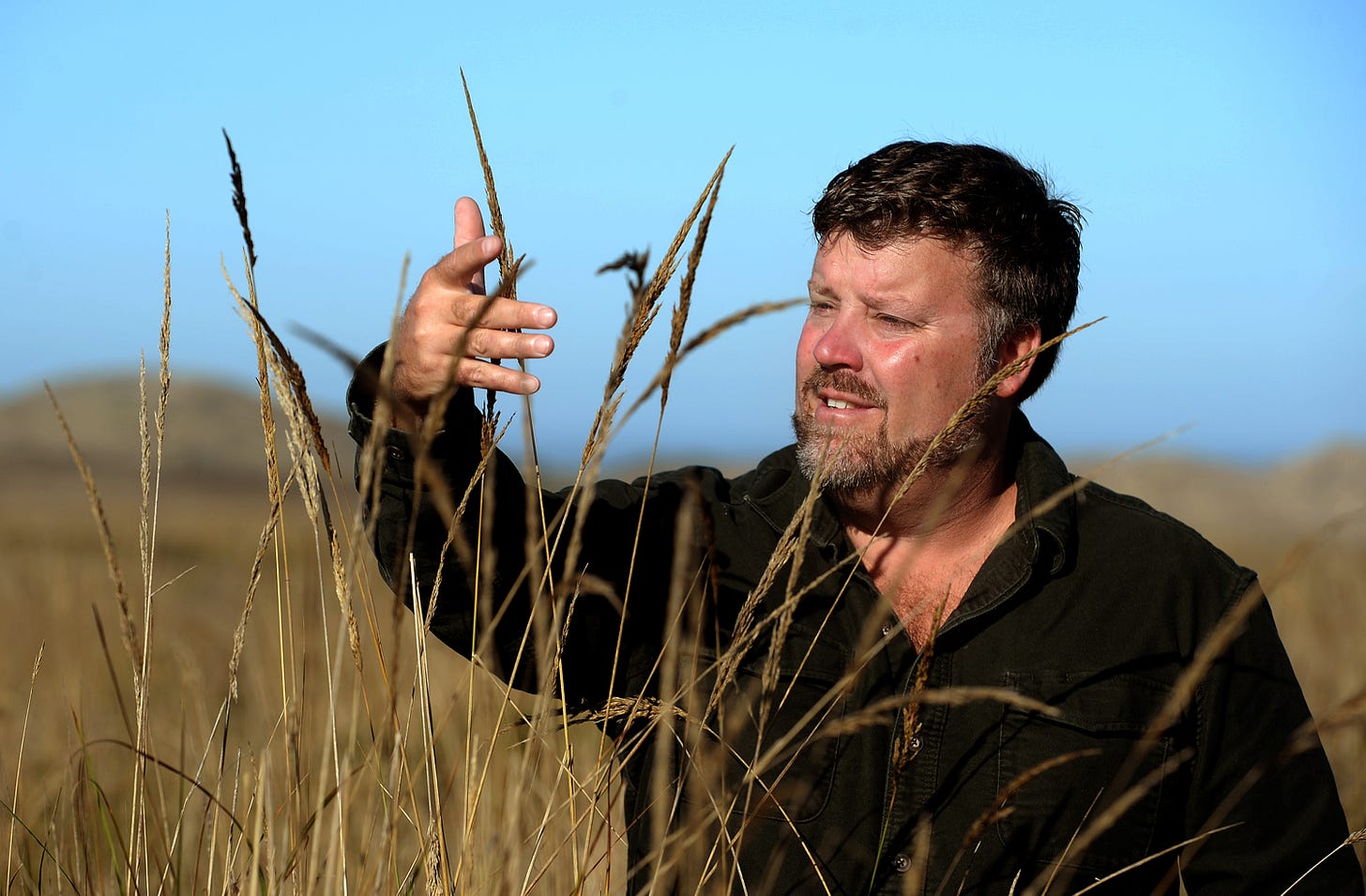
“Our first thought was, we’re the only ranchers left out here. I am surrounded by dairies and ranches, people I grew up with. Even when we had differences I always knew I could rely on them. It was really quite a shock emotionally.”
But he was also shocked by how much the ROD dictated his own future without his input.
“I was jaw-dropped at how much time was put into what my options were in the ROD without me ever having any input. It struck me as audacious, bold, and just disrespectful. They capped the number of cattle I could run and offered up some kind of land swap, taking away some of my lease and giving me some of my neighbors’ in a really weird scenario.”
The Park Service promised Evans he’d be able to negotiate. Multiple meetings later, he believed the Park Service was determined to squeeze him out slowly.
“The answer was ‘no’ on every single thing. I left there going, they don’t want me here. This isn’t a negotiation.”
Congressional investigation pending
Seven representatives from the House Committee on Natural Resources launched an investigation into what happened on Point Reyes after some emails revealed by journalist Chris Bray showed the Park Service appearing to celebrate the ranchers’ departure.
Last week Evans sent a letter to the committee, reading in part:
This is our family’s legacy, and our children are the fifth generation in our ranching family to learn to steward this land. We know that as the last ranching family on the peninsula, we will be the next target for these green groups. We will be harassed and pushed out, and family ranching on this peninsula will be gone forever.
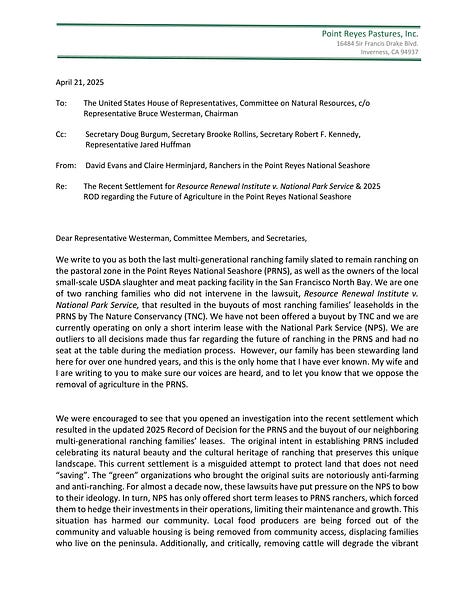
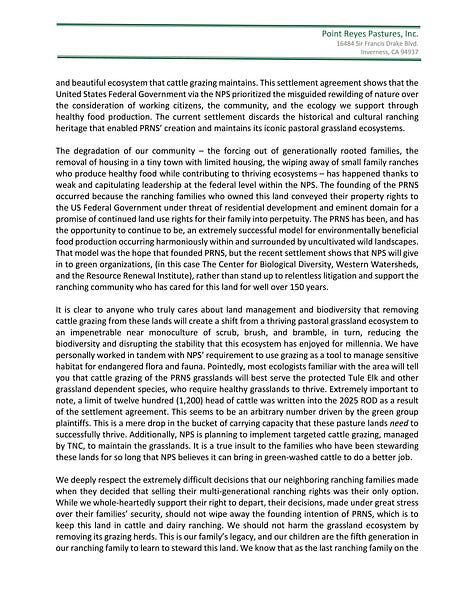
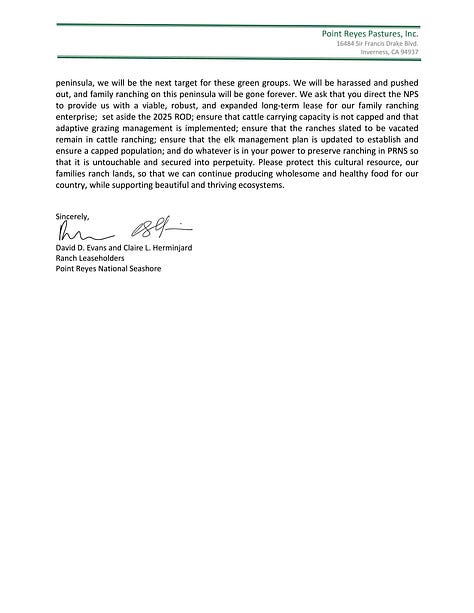
Evans has come to believe that the Park Service was complicit in the ranchers’ ouster.
“These green groups have used legal maneuvering and political savvy, and I now believe there’s been some coordination with them and the Park Service,” says Evans. “I’m sorry, Park Service workers don’t get to celebrate ranchers leaving. That, to me, smells terrible. These are public employees whose job is to implement what Congress envisioned for Point Reyes National Seashore. There’s something wrong here. I can’t help but think the green groups achieved what they achieved through capitulation from the Park Service, and that needs to be weeded out. It’s collusion, it’s conspiracy, and it’s illegal.”
He feels that the Park Service wants him to leave, too.
“They purposefully gave me a future there that was very meager and unsustainable.”
Representative Jared Huffman, a former environmental attorney, told The Press Democrat that the Point Reyes ranchers are happy about the deal, and that any change in the situation could result in The Nature Conservancy pulling out. Evans disputes this narrative, too.
“He’s almost speaking on The Nature Conservancy’s behalf saying they can back out if they don’t get what they want,” he says. “It sounds to me like the deal is pretty ironclad. What I’m asking for is that the 2025 ROD that removes agriculture from Point Reyes is set aside, and that the ranchers who want to leave get their buyouts, or they can decide to stay. But even if they don’t stay, that land needs to stay in agriculture.”

Future on Point Reyes
The original Point Reyes National Seashore Act, passed by Congress in 1962, enshrined agriculture on the peninsula.
“Everybody who has an interest in this should read the Point Reyes Act and follow-up legislation and look at what’s going on today and ask themselves some really honest questions. Is this the way it was meant to be?”
Evans says the area is pristine and desirable to visitors not in spite of legacy grazing operations, but because of them.
“Point Reyes isn’t broken, it didn’t need to be saved,” Evans says. He speaks passionately about his commitment to grazing. “I’ve spent more time in these fields than any staff or tourist or visitor. I can see how beneficially grazed livestock does not steal away from nature or natural communities or wildlife; it enhances it. Just a couple days ago I saw no less than fifteen blue herons in the pasture I just moved cattle out of after intensive grazing. This is what we should be talking about. We have such an awesome opportunity here on Point Reyes, and the public has not been allowed and encouraged to access what’s going on here.”
Evans calls the idea that urban-fringed pastoral zones like Point Reyes can be preserved without humans a “total joke.”
“What upsets me most is this was a major chance to have humans managing natural resources, producing food,” he says. “Farmers in a national park, operating harmoniously while being surrounded by wild land and wild populations. That’s an awesome opportunity. Because ultimately humans have to figure out how to live in harmony with nature.”
He wants tourists and visitors to experience the unique marriage of regenerative agriculture and public land that has been part of the culture on Point Reyes since the passage of the Point Reyes Act. For Evans, ranching here is in his blood—going back generations. Point Reyes has been grazed by cattle for over 150 years.
“Tourists come to Point Reyes and I think most appreciate the pastoral landscape, whether they know it’s created by grazing livestock or not. You can’t help but love green rolling hills. It’s grazing that allows you to see wildlife. We need a future that opens the door so visitors can come to my farm and tour the fields with me and understand the history of ranching and buy a steak and bottle of milk before you leave. Why has our government denied this access?”



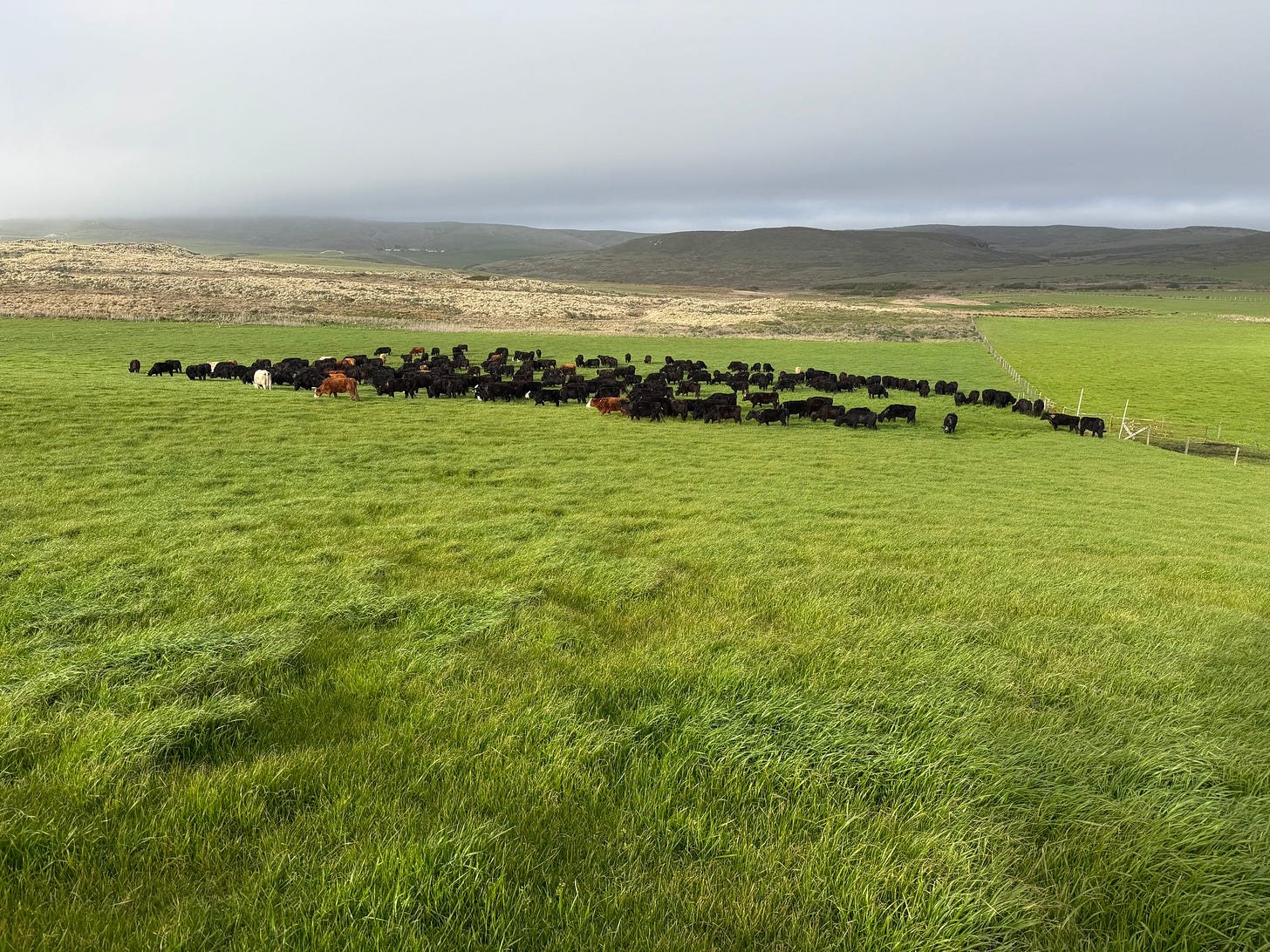

Why do I believe this has nothing to do with environmental concerns but more to grab the land while simultaneously eliminating private ranches and dairy farms? After all, cows and cattle fart, and Globalists want to control food. We need more private ranchers, less Tyson, Cargill, and JBS, and the same for dairy.
Thank you again for another enlightening article. Mr. Evans is spot on and makes eloquent statements IN FAVOR of beneficial human interaction with the land. I wish him and his family all the best in this insidious overreach from organizations who know little to nothing about what that land is actually capable of.